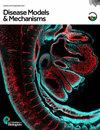GATA6-CXCR7 信号缺陷导致主动脉瓣双瓣。
IF 4
3区 医学
Q2 CELL BIOLOGY
引用次数: 0
摘要
心脏流出道(OFT)瞬间连接心室和主动脉囊,并形成动脉瓣膜。这些瓣膜的异常,如主动脉瓣二尖瓣(BAV),是常见的先天性畸形。GATA6失活变体会导致心脏OFT缺陷和BAV,但其机制尚不清楚。我们利用 CRISPR-Cas9 生成了 Gata6STOP/+ 小鼠,它们表现出高穿透性 BAV(70%)和膜室间隔缺损(43%)。这些小鼠在 OFT 中表现出增殖减少和 ISL1 阳性祖细胞增多,表明心血管分化异常。用 Mef2cCre 驱动系缺失 Gata6 可重现 Gata6STOP/+ 表型,这表明 Gata6 在第二心田具有细胞自主作用。Gata6STOP/+小鼠的OFT长度和口径减少,这与心脏神经嵴细胞贡献不足有关,可能导致瓣膜-室间隔缺陷。RNA测序分析表明,与细胞增殖和迁移相关的通路出现缺失,Cxcr7(又称Ackr3)是一个候选基因。在 Gata6STOP/+ OFT 组织中观察到间质细胞迁移和侵袭减少。CXCR7激动剂能减少野生型间质细胞的迁移并增加侵袭,但不能增加Gata6STOP/+外植体的侵袭,这表明CXCR7在OFT发育过程中起着依赖于GATA6的作用,并可能与BAV有关。本文章由计算机程序翻译,如有差异,请以英文原文为准。
Deficient GATA6-CXCR7 signaling leads to bicuspid aortic valve.
The cardiac outflow tract (OFT) transiently links the ventricles to the aortic sac and forms the arterial valves. Abnormalities in these valves, such as bicuspid aortic valve (BAV), are common congenital anomalies. GATA6-inactivating variants cause cardiac OFT defects and BAV, but their mechanisms are unclear. We generated Gata6STOP/+ mice using CRISPR-Cas9, which show highly penetrant BAV (70%) and membranous ventricular septal defects (43%). These mice exhibited decreased proliferation and increased ISL1-positive progenitor cells in the OFT, indicating abnormal cardiovascular differentiation. Gata6 deletion with the Mef2cCre driver line recapitulated Gata6STOP/+ phenotypes, indicating a cell-autonomous role for Gata6 in the second heart field. Gata6STOP/+ mice showed reduced OFT length and caliber, associated with deficient cardiac neural crest cell contribution, which may cause valvulo-septal defects. RNA-sequencing analysis showed depletion in pathways related to cell proliferation and migration, highlighting Cxcr7 (also known as Ackr3) as a candidate gene. Reduced mesenchymal cell migration and invasion were observed in Gata6STOP/+ OFT tissue. CXCR7 agonists reduced mesenchymal cell migration and increased invasion in wild-type but not in Gata6STOP/+ explants, indicating the GATA6-dependent role of CXCR7 in OFT development and its potential link to BAV.
求助全文
通过发布文献求助,成功后即可免费获取论文全文。
去求助
来源期刊

Disease Models & Mechanisms
医学-病理学
CiteScore
6.60
自引率
7.00%
发文量
203
审稿时长
6-12 weeks
期刊介绍:
Disease Models & Mechanisms (DMM) is an online Open Access journal focusing on the use of model systems to better understand, diagnose and treat human disease.
 求助内容:
求助内容: 应助结果提醒方式:
应助结果提醒方式:


